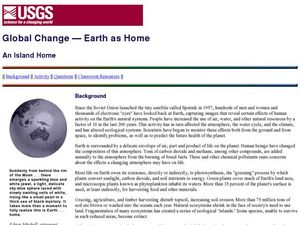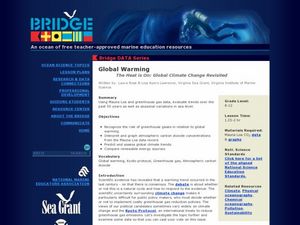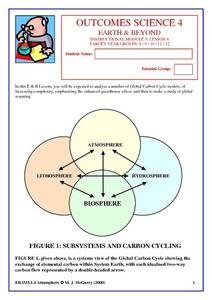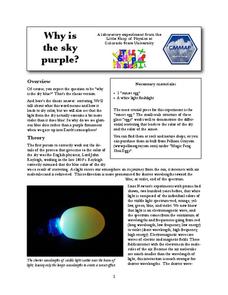Curated OER
Making Clouds: Aerosol-Cloud Interactions in a Beaker
Students observe a teacher demo on how clouds form. In this earth science lesson, students discover how cloudiness affects relative humidity. They explain the scattering of light by clouds.
Curated OER
Viewpoint on Causes of Global Warming - An Assignment Using Anonymous Electronic Peer Review With a Dropbox
Students are told that studies exist that suggest human activities are not causing warming of the Earth. Students are given the opportunity to further their writing, critical thinking and reasoning skills. While enhancing their computer...
Curated OER
Hawaiian Hot Spots
Young scholars describe how plate tectonics contribute to the development of volcanoes. In this earth science lesson, students examine the map of Hawaii and explore the physical and biological environment there. They write a story about...
Curated OER
Volcanoes and Urban Planning
Students analyze satellite image data of Volcan Villarica. In this earth science lesson plan, students identify dangerous areas surrounding the volcano. They propose a new safe location for the town.
Curated OER
Global Change- Earth as Home
Students create their own environment. In this environmental protection lesson, students pretend they are the owners of a tropical island. They create jobs for the citizens and develop the island as a model environment.
Curated OER
Winter Season
Young scholars recognize the relationship between Earth's tilt and the Winter season. In this Winter lesson plan, students work in pairs to complete make frost and design snow goggles. Young scholars experiment a hand lens to study the...
Curated OER
Global Warming - The Heat is On: Global Climate Change Revisited
After listening to your lecture on climate change, young scientists access NOAA's database listing Mauna Loa's carbon dioxide data. They graph the monthly means and then compare their graphs to NOAA's. This is a concise plan that could...
Curated OER
The Geography - Writing Connection
Students examine and describe the four physical systems of the Earth. Using two of the systems, they practice their writing skills and use vocabulary associated with the different types of landforms. They predict the types of shelters...
Curated OER
Ocean Streams
The instructions for demonstrating ocean turnover are provided in this resource. You could set this up for your earth science class as part of a lecture on convection currents or as an explanation of how ocean currents form. An animation...
Curated OER
Outcomes Science 4: Earth & Beyond
In this earth and beyond science worksheet, students read through an 18 page packet containing information and questions pertaining to global carbon cycles. There are website links available on the pages where additional information on...
Curated OER
Circle the Earth - Explore Surface Types on a Journey around Earth
Students use CERES percent coverage surface data with a world map in locating landmasses and bodies of water at Earth's Equator.
Curated OER
Earth From Space
Students watch a series of programs from NASA titled "Earth From Space". After viewing the program, they identify ways NASA is researching the reasons why the Earth is changing. They discuss the various levels of the atmosphere and...
Curated OER
Sea of Air #3
In this air worksheet, students determine the major gases found in the earth's atmosphere and review STP and Avogadro's Law. This worksheet has 1 true or false, 2 fill in the blank, and 7 short answer questions.
Curated OER
Do Some Research: Science 1
In this science research worksheet, students read the sentence and use a library or the Internet to find the answer and write it on the blue line. Students must then write a report about this topic: what is the layer of air that...
Curated OER
Outcomes Science 4: Earth & Beyond
In this earth and beyond science worksheet, students read through 11 pages of information on weather, global warming, climate change and other related topics. There are many website links on the pages that provide additional information...
Curated OER
Energy Efficiency Ambassadors
Students compare two products that provide the same function but require different amounts of energy. In this energy efficiency lesson students research and demonstrate energy efficiency in action and how it applies to...
Curated OER
Weather and Wind
Learners study wind and its effect on weather. In this investigative instructional activity students write a report on wind and weather and create a movement sequence.
Curated OER
Atmospheric Shielding from Radiation II
In this radiation worksheet, students calculate the total shielding along several specific directions defined by the angles. This worksheet has 3 problems to solve.
Curated OER
Earth's Atmosphere
In this atmosphere worksheet, students will fill in information about each of the earth's atmospheric layers, including the troposphere, stratosphere, and mesosphere.
NOAA
Why Should I Care?: Show How Increased Carbon Dioxide Makes the Ocean More Acidic
How does a change in pH affect the ocean ecosystem? Scholars explore the idea by making an acid-base indicator in part seven of the 10-installment Discover Your Changing World series. First, they explore impacts of carbon dioxide in...
Curated OER
Sunlight and the Earth # T
Students learn that convection of heat in the atmosphere is the cause of weather phenomena. They learn that water vapor also carries solar heat and plays an important role in atmospheric convection.
Colorado State University
What Is a "Model"?
Model the transfer of energy during a typical 24-hour period. Young scholars use a game-like approach to learning the patterns of heat transfer through the day and night. Groups of four exchange different tokens as the energy...
Curated OER
It's Raining, It's Pouring: The Water Cycle
Students investigate the relationship of the steps in the water cycle, and create a simulation of the water cycle in a jar.
Colorado State University
Why Is the Sky Purple?
The color of the sky depends on the time of day. Young scholars experiment with scattering different wavelengths of light to recreate the color of the sky. They observe both the longer blue wavelengths and the shorter red and orange...
























